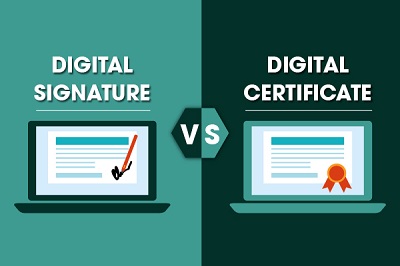Digital Signature vs Digital Certificate: What’s the Difference
Although a digital certificate and a digital signature are similar in some aspects, they have differences too that you should understand to use them effectively.
Digital signatures and Digital certificates are two essential aspects of the World Wide Web. In this article, we will first explain these two terms and how they are used in general.

What is a Digital Signature?
A digital signature verifies the authenticity of a document or a message. Typically, it involves public key cryptography.
An algorithm generates a public key and a corresponding private key by taking a random input for increased security.
Let’s assume the sender is sending a signed contract in a document form.
The sender will sign his document with his private key. And, the receiver gets the document along with the signature. A signature verifying algorithm can identify that the document is signed by the sender and is not tampered during the transmission. Alternatively, the receiver can request the sender to verify the authenticity of the document.
Digital signatures are used in online messaging applications, emails, and digital contacts. MarketsandMarkets estimates that the digital signature market will grow to USD 5.5 billion globally.
Some algorithms used in Digital Signature systems are, but not limited to:
- RSA (Rivest, Shamir, Adelman)
- DSA (Digital Signature Algorithm)
- ECDSA (Elliptical Curve Digital Signature Algorithm)
How does a Digital Signature work in practice?
Suppose, Alice signs a document and sends it to Bob.
- Alice generates a key pair (Public Key and Private Key) using a Public Key Infrastructure (PKI) system, if not done already.
- Alice signs the document with her Private Key. The Private Key is confidential, and only Alice will have access to it.
- Bob receives the document and verifies the authenticity of the document with Alice’s Public Key using the PKI system.
- If the document is not tampered or altered during transmission or later, validation will be successful, and Bob can trust that the document is originally from Alice.
Benefits of Digital Signature
- Secure communication and transmission of messages over untrusted or public channels (for example, open internet).
- Legal binding of contacts. Once signed, the signed parties cannot deny a contract they have agreed to.
- In certain jurisdictions, digital signatures are valid but bound to certain laws.
- Prevents data tampering and document tampering.
Types of Digital Signatures
The type of digital signature depends on the cryptographic algorithm used and how the involved PKI system is implemented. At the moment, there are 3 types of digital signatures like simple, basic and advanced signatures.
- A simple signature is not protected with encryption. It is like a wet signature written on a document.
- Basic Signatureis not so different from a simple signature but it can show any changes done after making the document’s signature.
- Advanced Signature is different from simple and basic signature and is made with asymmetric cryptography and public key infrastructure. It also shows which device was used and what changes were made after the document was signed.
What is a Digital Certificate?
A digital certificate is known as a public key certificate also verifies the ownership of a public key.
For example, let’s say you’re visiting a website example.com to perform a secure transaction. Example.com is a legitimate site, and you know the information you transmit to them will be secure. For this transmission, your web browser encrypts your data with the Public Key of example.com so that only the private key of example.com can decrypt the data.
When you visit example.com on your browser, how do you know that the public key supplied belongs to example.com? What if an attacker in the middle has tampered communication and supplied his own public key?
A digital certificate exactly solves this issue. A certificate authority (CA), also known as a trusted third-party, in the PKI system validates the public key of example.com and issues a digital certificate. Typically, the CA acts as a guarantor for the authenticity of the public key. Your web browser recognizes the certificates issued by the certificate authorities and signals that the connection to example.com is secure.
While this is just one example, in other digital transmissions and communications, the PKI system will have a valid mechanism to verify and validate the digital certificates involved.
Various types of SSL certificates are the best examples of a digital certificate.
Types of Digital Certificates
-
Certificate Authority (CA) certificates
A CA certificate validates the identity of the certificate authority it is issued to.
-
Server or client certificates
Client certificates are known to make secure communication. They are used to identify one device to another device, one person to another person. Two parties do mail communication and they require a client certificate.
-
Object signing certificates
These certificates are used for signing digital objects such as documents and other types of files, generally in an enterprise ecosystem.
-
Signature verification certificates
Signature verification certificates are object signing certificates without the Private Key. These are used to authenticate signatures signed by using an object signing certificate.
-
User certificates
This is a digital credential that verifies the identity of the owner of the certificate; many applications now use credentials to verify users to resource instead of password and username.
Digital Signature vs Digital Certificate
The following are the fundamental differences between a digital signature and digital certificate.
| Aspect | Digital Signature | Digital Certificate |
|---|---|---|
| Basic Definition | The signing entity uses a digital signature to ensure the authenticity of data or documents. | Certifies the signing entity and that the signature originally belongs to a particular person or entity. |
| Process | The signing entity generates a key pair. Uses Private Key to sign and publishes Public Key for verification. | Validates the authenticity of the Public Key. |
| Security | Ensures the data is not tampered and legally binds the validity of contracts. | Proves the authenticity of the certificate owner. |
| Common uses | Messaging, emails, and contracts. | Used for initiating a secure connection between browser and server. |
Conclusion
Digital signatures and digital certificates are closely related. Their applications and uses depending on the context of how these systems are implemented and how the relative PKI infrastructure works. Sometimes, a digital certificate is also called a digital signature certificate as it validates the public key (authenticity) of the signing entity.


